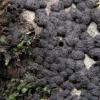
20-12-2025 15:47
Mirek GrycHi.These grew on pine wood that was heavily covere

18-12-2025 21:17
Pol DebaenstThe identification took me to Byssonectria deformi

15-12-2025 07:09
 Danny Newman
Danny Newman
indet. Rutstroemiaceae sp. on unk. fallen leavesMc

19-12-2025 10:10
Patrice TANCHAUDBonjour, récolte réalisée en milieu dunaire, a

18-12-2025 17:23
 Bruno Coué
Bruno Coué
Bonjour,je serais heureux d'avoir votre avis sur c

18-12-2025 18:07
Margot en Geert VullingsThese plumes were found on rotten wood.They strong

17-12-2025 18:35
 Michel Hairaud
Michel Hairaud
Bonjour à tous/Hi to everyone I am passing along

15-12-2025 15:48
 Danny Newman
Danny Newman
Melanospora cf. lagenaria on old, rotting, fallen
Hypoxylon multiforme?
VASILEIOS KAOUNAS,
19-09-2008 07:22
Spores 10,2-11,6*4,2-5,2 ìm, Q=2,2-2,6
Christian Lechat,
19-09-2008 08:33

Re:Hypoxylon multiforme?
Difficult to say with so few elements, but it looks like H. cohaerens.
Regards,
Regards,
Jacques Fournier,
19-09-2008 08:48

Re:Hypoxylon multiforme?
Hi Vasileios,
H. cohaerens is specific for Fagus. Otherwise its main difference with H multiforme is the germ slit length on ascospores: short in multiforme, spore-length in cohaerens, best seen in KOH.
You can visit http://pyrenomycetes.free.fr/ for more informations.
Best wishes,
Jacques
H. cohaerens is specific for Fagus. Otherwise its main difference with H multiforme is the germ slit length on ascospores: short in multiforme, spore-length in cohaerens, best seen in KOH.
You can visit http://pyrenomycetes.free.fr/ for more informations.
Best wishes,
Jacques
VASILEIOS KAOUNAS,
19-09-2008 08:52
Re:Hypoxylon multiforme?
Thank you very much for your correspondence
Andrew N. Miller,
19-09-2008 18:08

Re:Hypoxylon multiforme?
I believe both H. multiforme and H. cohaerens (along with H. truncatum and H. annulatum) have all been transferred to the new genus, Annulohypoxylon by Y.-M. Ju, J.D. Rogers & H.-
M. Hsieh.
Andy
M. Hsieh.
Andy
Jacques Fournier,
19-09-2008 18:48

Re:Hypoxylon multiforme?
Hi Andy,
you are perfectly right as to the new name Annulohypoxylon but I told Vasileios to visit my website, which has not been updated since this change....names change but fortunately fungi do not much ..
Jacques
you are perfectly right as to the new name Annulohypoxylon but I told Vasileios to visit my website, which has not been updated since this change....names change but fortunately fungi do not much ..
Jacques


